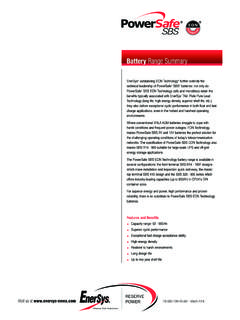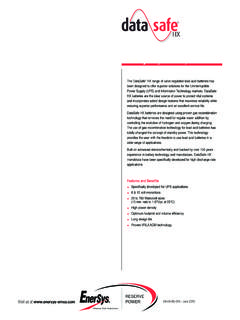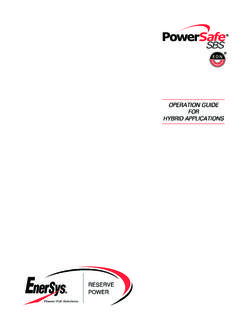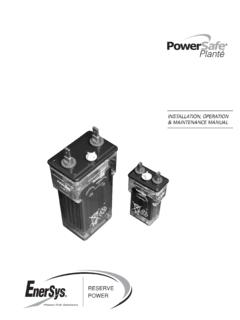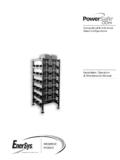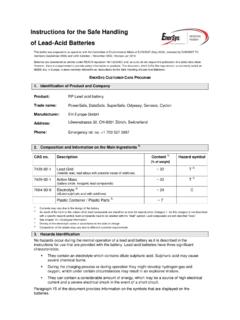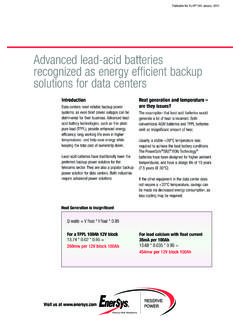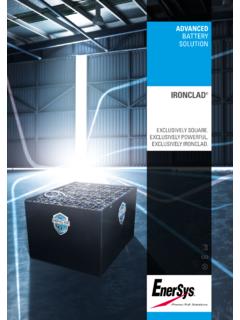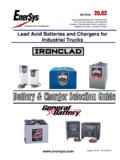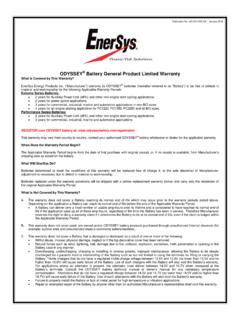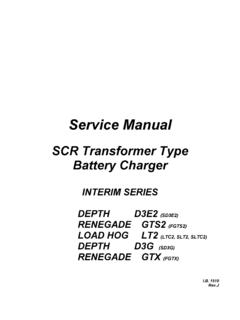Transcription of RESERVE POWER - EnerSys - EMEA
1 OPERATION GUIDEFOR HYBRIDAPPLICATIONSRESERVEPOWER1. General Operating Operating Temperature RangeThe recommended operating temperature range for PowerSafe SBSEON Technology batteries in hybrid applications is -40 C to +50 life and performance are attained at +20 C, however, withthe correct controls in place, cyclic performance in hybridapplications is not impacted by elevated temperatures (providing thatthe maximum battery temperature is not allowed to exceed +50 C). StoragePowerSafe SBS EON Technology battery types have a shelf life of 2years when stored at 20 C.
2 Higher temperatures increase the rate ofself discharge and reduce storage 1 gives the relationship between storage time, open circuitvoltage (OCV) and state of charge as a function of Freshening ChargePowerSafe SBS EON Technology battery types must be given afreshing charge when the OCV approaches Volts/cell or whenmaximum storage time is reached (whichever occurs first).The freshening charge should be conducted using constant voltage inthe range of to volts per cell for a period of 24 hours. Thecharge current should be limited to a value expressed numerically inAmps as 10% of the 10 hour capacity rating of the battery (ie.)
3 19 Amps for SBS 190F).The maximum storage times between refresh charge andrecommended OCV audit frequency is given in the table TimeOCV Audit Interval( C / F)(Months)(Months)+10 / +50486+15 / +59346+20 / +68244+25 / +77174+30 / +86123+35 / + +40 / + CommissioningPrior to commencement of cyclic duty, the battery must be given acommissioning charge. This shall consist of 24 hours charge at avoltage equivalent to Volts/cell with no load Fast ChargingFast charge techniques must be used for frequent discharge cyclicapplications. In such applications the rectifier output voltage shouldbe set at Volts/cell (20 C).
4 Current LimitInherent low internal resistance allows PowerSafe SBS EONT echnology battery types to accept in-rush currents up to 600% C10amps ( PowerSafe SBS 190F in-rush current up to 1140 Amps).For reliable cyclic performance and to achieve maximum cycle lifepotential, the acceptable recharge current limit range is to 1C10 Amps ( for PowerSafe SBS 190F the recharge current range is19 Amps to 190 Amps per series string). DisposalPowerSafe SBS EON Technology batteries are recyclable. End of lifebatteries must be packaged and transported according to prevailingtransportation rules and regulations.
5 End of life batteries must bedisposed of in compliance with local and national laws by a licensedbattery Cyclic Operation Cyclic PerformancePowerSafe SBS EON Technology has been developed from provenSBS Thin Plate Pure Lead (TPPL) technology, to provide the addedcapability of delivering higher levels of cyclic performance asillustrated in figure order to achieve the cycle life shown in figure 2 PowerSafe SBSEON Technology batteries must be returned to full state of chargeusing the charge regime options recommended by EnerSys prior tocommencement of the next discharge cycle.
6 Operating at partial stateof charge will significantly reduce cycle DischargeDepth of discharge must be measured using an Ah counting device,with an accuracy 1% of full range of expected discharge cyclecurrents. The classification of the shunt should be minimum of A low voltage disconnect should be used to protect the battery fromabusive deep discharge (typically Volts/cell). Recharge Optimum cycle life (figure 2) is achieved by controlling the amount ofrecharge back into the battery to a level where 103% of dischargedAh is returned. Controlled recharge can be achieved by Ah countingusing a device capable of measuring float current equivalent to100mA/100Ah of installed battery capacity.
7 Alternatively, where Ah counting during recharge is not available, it ispossible to calculate the required recharge time based upon thefollowing time (hrs) = ((discharged Ah* ) / recharge current limit)*2+1 ExamplePowerSafe SBS 190F discharge to 80% depth of discharge removes152Ah. With a current limit of (95 Amps), the time torecharge the battery is:Time (hrs) = ((152* ) / 95)*2+1= ( )*2+1= *2+1= +1= of time to full state of charge using the above formula forvarious depths of discharge and current limits is shown in figure Circuit Voltage per CellApprox.
8 State of Charge (%)Months0612182430364248+40 C+30 C+25 C+20 C+10 CFigure 1 Time (hrs)Depth of Discharge 1816141210864200%10%20%30%40%50%60%70%80 %90%100%110% Amps Amps Amps Amps 1C10 Amps Time to Full State of ChargeAs a Function of Current Limit and Depth of Discharge(Recharge )Figure 3 Figure 2 PowerSafe SBS EON Technology Cycle Life as a Function of Depth of Discharge (C10 Rate)(Charge Using Optimum EON Technology Recommendations)The time to reach full state of charge is influenced by batterytemperature and charge voltage during the ) Where Ah counting is used to control the recharge ( ofdischarged Ah is returned) the battery voltage can be maintainedat a constant Volts/cell provided that the battery temperatureis controlled at or below +50 C discharged Ah returned.
9 2) Where time formula recharge is used, temperature compensationfor charge voltage should be applied at the rates shown in figure rectifier voltage cannot be adjusted to values > Volts/cellto compensate for temperatures below 20 C, the time to full state ofcharge will be increased. For additional information and guidance onthis, please contact your EnerSys the end of controlled recharge the battery can revert to eitherdischarge mode, or where the battery is used to provide mainsback up the voltage should be reduced to float voltage level Data RecordingIn order for the warranty to be valid, the user must provide, by meansof routine regular data logging, the following data.
10 1) The number of cycles performed and the depth of discharge( dod ) of each ) The duration of each discharge and charge cycle, and the Ah inand ) Full details of the recharge voltage/current profile for the last ) A full history of the ambient and battery surface temperatures,recorded at regular intervals throughout battery operation and ) The time and date of each event (an event is defined as thestart /stop of the battery discharge, the start/stop of the batteryrecharge, the start stop of any generator input POWER or other inputpower source, etc).


